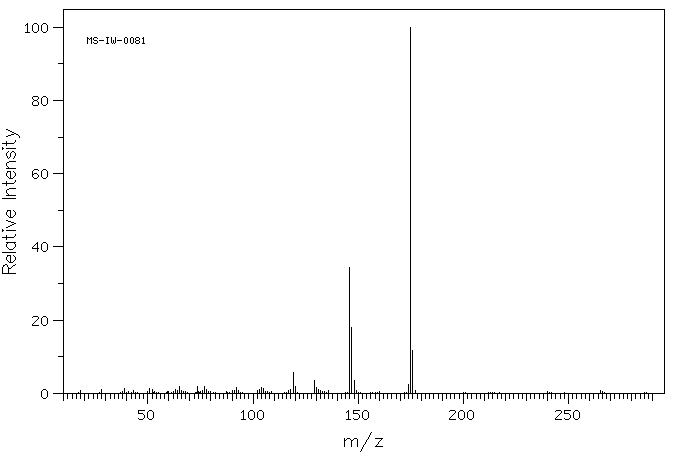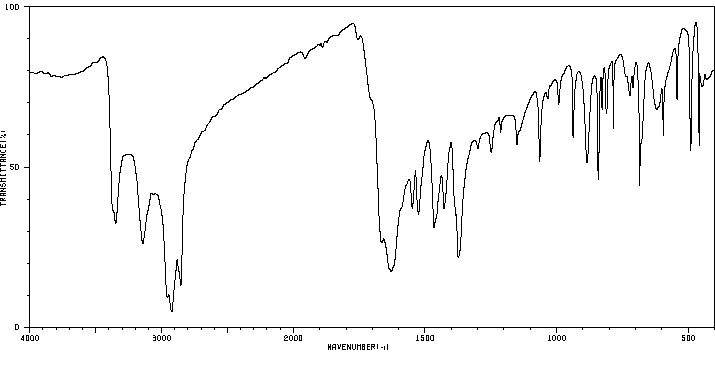7-氨基-4-甲基[1,8]萘啶-2-醇 | 1569-15-9
中文名称
7-氨基-4-甲基[1,8]萘啶-2-醇
中文别名
——
英文名称
7-Amino-2-hydroxy-4-methyl-1.8-naphthyridin
英文别名
4-Methyl-2-hydroxy-7-amino-1,8-naphthyridin;7-amino-4-methyl-1H-1,8-naphthyridin-2-one
CAS
1569-15-9
化学式
C9H9N3O
mdl
MFCD00006731
分子量
175.19
InChiKey
URBSEJOKAKIABF-UHFFFAOYSA-N
BEILSTEIN
——
EINECS
——
-
物化性质
-
计算性质
-
ADMET
-
安全信息
-
SDS
-
制备方法与用途
-
上下游信息
-
文献信息
-
表征谱图
-
同类化合物
-
相关功能分类
-
相关结构分类
物化性质
-
熔点:405 °C (decomp)
-
沸点:394.9±35.0 °C(Predicted)
-
密度:1.42±0.1 g/cm3(Predicted)
计算性质
-
辛醇/水分配系数(LogP):0.2
-
重原子数:13
-
可旋转键数:0
-
环数:2.0
-
sp3杂化的碳原子比例:0.111
-
拓扑面积:68
-
氢给体数:2
-
氢受体数:3
安全信息
-
海关编码:2933990090
SDS
| Name: | 7-Amino-4-Methyl-1 8-Naphthyridin-2-ol 98 % Material Safety Data Sheet |
| Synonym: | 2-Amino-7-Hydroxy-5-Methyl-1,8-Naphthyridine |
| CAS: | 1569-15-9 |
Synonym:2-Amino-7-Hydroxy-5-Methyl-1,8-Naphthyridine
Section 2 - COMPOSITION, INFORMATION ON INGREDIENTS
| CAS# | Chemical Name | content | EINECS# |
| 1569-15-9 | 7-Amino-4-Methyl-1,8-Naphthyridin-2-ol | 98 | 216-375-0 |
Risk Phrases: 36/37/38
Section 3 - HAZARDS IDENTIFICATION
EMERGENCY OVERVIEW
Irritating to eyes, respiratory system and skin.The toxicological properties of this material have not been fully investigated.
Potential Health Effects
Eye:
Causes eye irritation. May cause chemical conjunctivitis.
Skin:
Causes skin irritation.
Ingestion:
May cause gastrointestinal irritation with nausea, vomiting and diarrhea. The toxicological properties of this substance have not been fully investigated.
Inhalation:
Causes respiratory tract irritation. The toxicological properties of this substance have not been fully investigated. Can produce delayed pulmonary edema.
Chronic:
Effects may be delayed.
Section 4 - FIRST AID MEASURES
Eyes: Flush eyes with plenty of water for at least 15 minutes, occasionally lifting the upper and lower eyelids. Get medical aid.
Skin:
Get medical aid. Flush skin with plenty of water for at least 15 minutes while removing contaminated clothing and shoes. Wash clothing before reuse.
Ingestion:
Never give anything by mouth to an unconscious person. Get medical aid. Do NOT induce vomiting. If conscious and alert, rinse mouth and drink 2-4 cupfuls of milk or water.
Inhalation:
Remove from exposure and move to fresh air immediately. If not breathing, give artificial respiration. If breathing is difficult, give oxygen. Get medical aid.
Notes to Physician:
Treat symptomatically and supportively.
Section 5 - FIRE FIGHTING MEASURES
General Information:
As in any fire, wear a self-contained breathing apparatus in pressure-demand, MSHA/NIOSH (approved or equivalent), and full protective gear. During a fire, irritating and highly toxic gases may be generated by thermal decomposition or combustion.
Extinguishing Media:
Use agent most appropriate to extinguish fire. Use water spray, dry chemical, carbon dioxide, or appropriate foam.
Section 6 - ACCIDENTAL RELEASE MEASURES
General Information: Use proper personal protective equipment as indicated in Section 8.
Spills/Leaks:
Clean up spills immediately, observing precautions in the Protective Equipment section. Sweep up, then place into a suitable container for disposal. Avoid generating dusty conditions. Provide ventilation.
Section 7 - HANDLING and STORAGE
Handling:
Wash thoroughly after handling. Remove contaminated clothing and wash before reuse. Use with adequate ventilation. Minimize dust generation and accumulation. Avoid contact with eyes, skin, and clothing. Keep container tightly closed. Avoid ingestion and inhalation.
Storage:
Store in a tightly closed container. Store in a cool, dry, well-ventilated area away from incompatible substances.
Section 8 - EXPOSURE CONTROLS, PERSONAL PROTECTION
Engineering Controls:
Facilities storing or utilizing this material should be equipped with an eyewash facility and a safety shower. Use adequate ventilation to keep airborne concentrations low.
Exposure Limits CAS# 1569-15-9: Personal Protective Equipment Eyes: Wear appropriate protective eyeglasses or chemical safety goggles as described by OSHA's eye and face protection regulations in 29 CFR 1910.133 or European Standard EN166.
Skin:
Wear appropriate protective gloves to prevent skin exposure.
Clothing:
Wear appropriate protective clothing to prevent skin exposure.
Respirators:
A respiratory protection program that meets OSHA's 29 CFR 1910.134 and ANSI Z88.2 requirements or European Standard EN 149 must be followed whenever workplace conditions warrant respirator use.
Section 9 - PHYSICAL AND CHEMICAL PROPERTIES
Physical State: Powder
Color: brown
Odor: None reported.
pH: Not available.
Vapor Pressure: Not available.
Viscosity: Not available.
Boiling Point: Not available.
Freezing/Melting Point: > 300 deg C
Autoignition Temperature: Not applicable.
Flash Point: Not applicable.
Explosion Limits, lower: Not available.
Explosion Limits, upper: Not available.
Decomposition Temperature:
Solubility in water:
Specific Gravity/Density:
Molecular Formula: C9H9N3O
Molecular Weight: 175.19
Section 10 - STABILITY AND REACTIVITY
Chemical Stability:
Stable at room temperature in closed containers under normal storage and handling conditions.
Conditions to Avoid:
Incompatible materials, dust generation, excess heat, strong oxidants.
Incompatibilities with Other Materials:
Oxidizing agents.
Hazardous Decomposition Products:
Nitrogen oxides, carbon monoxide, irritating and toxic fumes and gases, carbon dioxide.
Hazardous Polymerization: Has not been reported.
Section 11 - TOXICOLOGICAL INFORMATION
RTECS#:
CAS# 1569-15-9 unlisted.
LD50/LC50:
Not available.
Carcinogenicity:
7-Amino-4-Methyl-1,8-Naphthyridin-2-ol - Not listed by ACGIH, IARC, or NTP.
Section 12 - ECOLOGICAL INFORMATION
Section 13 - DISPOSAL CONSIDERATIONS
Dispose of in a manner consistent with federal, state, and local regulations.
Section 14 - TRANSPORT INFORMATION
IATA
Not regulated as a hazardous material.
IMO
Not regulated as a hazardous material.
RID/ADR
Not regulated as a hazardous material.
Section 15 - REGULATORY INFORMATION
European/International Regulations
European Labeling in Accordance with EC Directives
Hazard Symbols: XI
Risk Phrases:
R 36/37/38 Irritating to eyes, respiratory system
and skin.
Safety Phrases:
S 24/25 Avoid contact with skin and eyes.
S 28A After contact with skin, wash immediately with
plenty of water.
S 37 Wear suitable gloves.
S 45 In case of accident or if you feel unwell, seek
medical advice immediately (show the label where
possible).
WGK (Water Danger/Protection)
CAS# 1569-15-9: No information available.
Canada
None of the chemicals in this product are listed on the DSL/NDSL list.
CAS# 1569-15-9 is not listed on Canada's Ingredient Disclosure List.
US FEDERAL
TSCA
CAS# 1569-15-9 is not listed on the TSCA inventory.
It is for research and development use only.
SECTION 16 - ADDITIONAL INFORMATION
N/A
上下游信息
-
上游原料
中文名称 英文名称 CAS号 化学式 分子量 —— 2-Amino-5-chloromethyl-7-hydroxy-1,8-naphthyridine 130056-88-1 C9H8ClN3O 209.635 -
下游产品
中文名称 英文名称 CAS号 化学式 分子量 —— 2-ethyl-N-(5-methyl-1,5-naphtyridine)hexanamide 1561943-93-8 C17H23N3O2 301.389 2-氯-4-甲基-7-氨基-[1,8]二氮杂萘 2-chloro-4-methyl-7-amino-[1,8]naphthyridine 17884-05-8 C9H8ClN3 193.636 —— N-(7,8-dihydro-7-oxo-1,8-naphthyridin-2-yl)-2-ethylhexanamide 845548-22-3 C16H21N3O2 287.362 N-(7-氯-5-甲基-1,8-萘啶-2-基)乙酰胺 2-chloro-4-methyl-7-acetylamino-1,8-naphthyrine 1569-34-2 C11H10ClN3O 235.673
反应信息
-
作为反应物:描述:7-氨基-4-甲基[1,8]萘啶-2-醇 在 氢氧化钾 作用下, 以 乙醇 为溶剂, 反应 15.0h, 生成 2-(3'-phenylaminopropyloxy)-4-methyl-7-amino-1,8-naphthyridine参考文献:名称:Synthesis and Pharmacological Activities of 1,8-Naphthyridine Derivatives.摘要:在本研究中,合成了一系列2-取代-4-甲基-7-氨基/4,7-二甲基-1,8-萘啶,并通过红外、1H-NMR和元素分析进行了表征。研究了这些化合物的抗惊厥(125、250 mg/kg)、心脏和抗菌活性。筛选了这些化合物对革兰氏(+)细菌(表皮葡萄球菌、枯草芽孢杆菌、粪肠球菌和藤黄微球菌)和革兰氏(-)细菌(普通变形杆菌、铜绿假单胞菌、大肠杆菌和伤寒沙门氏菌)的抗菌活性。除2-(3'-苯氨基丙氧基)-4-甲基-7-氨基-1,8-萘啶外,所有化合物均表现出显着的抗惊厥活性。 2-(3-吗啉代-2'-羟基丙氧基)-4-甲基-7-氨基-1,8-萘啶、2-(3'-二苯氨基-2'-羟基丙氧基)-4-甲基-7的抗惊厥活性-氨基-1,8-萘啶和2-(3′-二乙醇氨基-丙氧基)-4,7-二甲基-1,8-萘啶在250 mg/kg剂量下被发现相当于地西泮(5 mg/千克)。使用 2-(3'-苯氨基-2'-羟基丙氧基)-4-甲基-7-氨基-1,8-萘啶、2-(3'-二乙醇氨基-2'-羟基丙氧基)-4-观察到交感神经阻滞活性仅甲基-7-氨基-1,8-萘啶和2-(3'-二苯氨基-2'-羟基丙氧基)-4-甲基-7-氨基-1,8-萘啶。所有化合物对测试细菌均缺乏抗菌活性。DOI:10.1248/bpb.25.798
-
作为产物:描述:参考文献:名称:Synthesis and Pharmacological Activities of 1,8-Naphthyridine Derivatives.摘要:在本研究中,合成了一系列2-取代-4-甲基-7-氨基/4,7-二甲基-1,8-萘啶,并通过红外、1H-NMR和元素分析进行了表征。研究了这些化合物的抗惊厥(125、250 mg/kg)、心脏和抗菌活性。筛选了这些化合物对革兰氏(+)细菌(表皮葡萄球菌、枯草芽孢杆菌、粪肠球菌和藤黄微球菌)和革兰氏(-)细菌(普通变形杆菌、铜绿假单胞菌、大肠杆菌和伤寒沙门氏菌)的抗菌活性。除2-(3'-苯氨基丙氧基)-4-甲基-7-氨基-1,8-萘啶外,所有化合物均表现出显着的抗惊厥活性。 2-(3-吗啉代-2'-羟基丙氧基)-4-甲基-7-氨基-1,8-萘啶、2-(3'-二苯氨基-2'-羟基丙氧基)-4-甲基-7的抗惊厥活性-氨基-1,8-萘啶和2-(3′-二乙醇氨基-丙氧基)-4,7-二甲基-1,8-萘啶在250 mg/kg剂量下被发现相当于地西泮(5 mg/千克)。使用 2-(3'-苯氨基-2'-羟基丙氧基)-4-甲基-7-氨基-1,8-萘啶、2-(3'-二乙醇氨基-2'-羟基丙氧基)-4-观察到交感神经阻滞活性仅甲基-7-氨基-1,8-萘啶和2-(3'-二苯氨基-2'-羟基丙氧基)-4-甲基-7-氨基-1,8-萘啶。所有化合物对测试细菌均缺乏抗菌活性。DOI:10.1248/bpb.25.798
文献信息
-
[1,8]naphthyridin-2-ones and related compounds for the treatment of schizophrenia申请人:Clark D. Jerry公开号:US20050043309A1公开(公告)日:2005-02-24This invention relates to compounds of the formula 1 wherein G, D, A, Z, Q, X, Y, R 1 , and R 4 through R 7 are defined as in the specification, processes for preparing the same and intermediates used in making the same, and pharmaceutical compositions containing such compounds and their use in the treatment of central nervous system disorders and other disorders.这项发明涉及公式1的化合物 其中G、D、A、Z、Q、X、Y、R 1 和R 4 至R 7 的定义如规范中所述,制备这些化合物的方法以及用于制备这些化合物的中间体,以及含有这些化合物的药物组合物及其在治疗中枢神经系统疾病和其他疾病中的用途。
-
Antithrombotic quinoxazolines申请人:Boehringer Ingelheim Pharma KG公开号:US06200976B1公开(公告)日:2001-03-13Quinoxazolines having antithrombotic activity. Exemplary of those disclosed are: 4-{[6-(N-carboxymethyl-quinolin-8-yl-sulphonylamino)-1-methyl-2-oxo-1,2-dihydroquinoxalin-3-yl]-methyl}-benzamidine, 4-{[6-(1-(N-cyclopentyl-carboxymethylcarbonylamino)-cyclo-propyl)-1-methyl-2-oxo-1,2-dihydroquinoxalin-3-yl]-methyl}-benzamidine, and 4-{[7-(N-carboxymethylaminocarbonyl-ethylamino)-4-methyl-quinolin-2-yl]-oxo}-benzamidine.
-
Supramolecular Self‐Sorting Networks using Hydrogen‐Bonding Motifs作者:Heather M. Coubrough、Stephanie C. C. van der Lubbe、Kristina Hetherington、Aisling Minard、Christopher Pask、Mark J. Howard、Célia Fonseca Guerra、Andrew J. WilsonDOI:10.1002/chem.201804791日期:2019.1.14objective in supramolecular chemistry is to mimic the transitions between complex self‐sorted systems that represent a hallmark of regulatory function in nature. In this work, a self‐sorting network, comprising linear hydrogen motifs, was created. Selecting six hydrogen‐bonding motifs capable of both high‐fidelity and promiscuous molecular recognition gave rise to a complex self‐sorting system, which超分子化学当前的一个目标是模拟复杂的自排序系统之间的转变,这些系统代表了自然界调节功能的标志。在这项工作中,创建了一个包含线性氢基序的自排序网络。选择六个能够进行高保真和混杂分子识别的氢键基序产生了一个复杂的自分类系统,其中包括能够自恋和社会自分类的基序。通过实验和计算检查各个组件之间的相互作用,为级联每个阶段的产物分布提供了基本原理。这一推理通过六个构建块的最多五次连续添加而成立,从而构建了一个仿生网络,其中不同组件的存在或不存在提供了多种独特的途径来实现不同的自排序配置。
-
1,4-Dithiino(2,3-c)pyrrole derivatives申请人:Rhone-Poulenc S.A.公开号:US03948917A1公开(公告)日:1976-04-06New compounds of the formula: ##SPC1## Wherein A is a phenyl, pyridyl, pyridazinyl, 2-, 3- or 4-quinolyl or naphthyridinyl radical, or a said radical substituted by one or two atoms or radicals selected from halogen, alkyl, alkoxy cyano and nitro, R is alkyl, alkenyl or hydroxyalkyl, and n is zero or 1, possess pharmacological properties and are, in particular, active as tranquilisers, anti-convulsant agents, decontracturants and agents to produce hypnosis.
-
Alternation and tunable composition in hydrogen bonded supramolecular copolymers作者:Thorsten Felder、Tom F. A. de Greef、Marko M. L. Nieuwenhuizen、Rint P. SijbesmaDOI:10.1039/c3cc46611f日期:——
A quadruple hydrogen bonded supramolecular copolymer is reported which combines preferred alternation with a continuously tunable composition.
报道了一种四重氢键超分子共聚物,它将首选交替结构与连续可调的组成相结合。
表征谱图
-
氢谱1HNMR
-
质谱MS
-
碳谱13CNMR
-
红外IR
-
拉曼Raman
-
峰位数据
-
峰位匹配
-
表征信息
同类化合物
(12羟基吲[2,1-b〕喹唑啉-6(12H)-酮)
黑暗猝灭剂BHQ-3,BHQ-3NHS
鸭嘴花酚碱
鸭嘴花碱酮;(S)-2,3-二氢-3,7-二羟基吡咯并[2,1-b]喹唑啉-9(1H)-酮
鸭嘴花碱酮
鸭嘴花碱盐酸盐
鲁米诺单钠盐
鲁米诺
骆驼蓬碱
颜料蓝64
颜料蓝60
顺式-卤夫酮
顺式-(喹喔啉-2-基)丙烯腈1,4-二氧化物
非奈利酮
青黛酮
雷替曲塞杂质1
阿法替尼杂质J
阿法替尼杂质I
阿法替尼杂质28
阿法替尼杂质18
阿法替尼杂质13
阿法替尼杂质
阿法替尼中间体
阿法替尼
阿法替尼
阿朴藏红
阿巴康唑
阿夫唑嗪杂质A
阿夫唑嗪杂质
阿夫唑嗪EP杂质C
阿夫唑嗪
阿喹司特
阿呋唑嗪杂质
阿呋唑嗪杂质
铜迈星
铁诱导细胞死亡激活剂
钠四丙基硼酸酯
酸性蓝98
酸性红101
酮色林醇
酞联氮基[2,3-b]酞嗪-5,14-二酮,7,12-二氢-
酞嗪-5-羧酸
酞嗪-2-氧化物
酚藏花红
酚嗪
酒石酸溴莫尼定
邻苯二甲酰肼
还原黄6GD
还原蓝6
达尼喹酮








